

A Resilient Symbol of Spring
|
The sight of flowers such as plum blossoms, cherry blossoms and azalea budding and adorning the landscape with their beautiful colours is a definite sign of spring. However, there is in fact another tell-tale sign, and that is the sight of bamboo shoots sprouting above the ground. You may associate bamboo with the famous Arashiyama Bamboo Forest in Kyoto, or the Tanabata festival in July, when people write their wishes and hang them on bamboo branches. Actually, the image of bamboo shoots breaking through the ground is heavily identified with spring, and even used as a kigo (seasonal word) in haiku. In the traditional Japanese calendar, there is even a microseason around 15 May that is named after bamboo – takenoko shozu (竹笋生).
Since ancient times, bamboo has been an integral part of Japanese culture. For instance, the bamboo ladle that is often seen at shrines and temples, which visitors use to cleanse their hands and mouth before entering. It has also been used during tea ceremonies to scoop water into the tea bowls from as long ago as the 15th century. Other common bamboo craftworks include folding fans, baskets, lanterns, sandals, and curtain blinds. Bamboo weaving or takeami (竹編み) has long been a traditional craft in Japan, with the oldest surviving bamboo basket being from the 8th century. There are a few reasons for its popularity. Bamboo craftworks are light and flexible yet sturdy, making it suitable for everyday use. Not to mention, it is also environmentally-friendly, and can be cultivated with little waste and pollution. This has encouraged the use of bamboo as an alternative material in daily products such as straws, hairbrushes, and toothbrushes. The bamboo is incorporated in much of Japanese architecture too. One common but often overlooked example is the bamboo fence, which often encloses Japanese gardens. It does not just serve as a divider, but also as a pleasant backdrop to these gorgeous gardens. Depending on how the bamboo pieces are placed, bamboo fences can be constructed to form various patterns. For instance, the bamboo fence at Koetsu Temple in Kyoto has a diamond pattern, allowing people to view the other side of the fence. The position and intensity of the knots also play an important role, and the black hemp-palm rope serves as a contrast to the paler bamboo fence. On a larger scale, bamboo was prominently used in the construction of the Japan Pavilion in Nagakute for the Expo 2005. The bamboo latticework stretched across the entire cocoon-like structure, reducing the build-up of heat and creating a comfortable, breezy escape from the sun. Indeed, the pavilion proved to be a success that combined traditional Japanese techniques and cutting-edge innovation. Besides utilising bamboo as it is, it may also be further processed. For example, there are innovative efforts to use bamboo in clothing, or more specifically, bamboo fibre. The fabric itself is especially absorbent and breathable, making it suitable for cooling summer clothes. Bamboo charcoal is also popular as it is able to absorb more moisture and odours compared to wood charcoal. Possessing natural properties as a dehumidifier and deodoriser, this has led to the creation of some surprising products using bamboo charcoal such as skin oil removers, and facial packs. Naturally, one cannot leave out the strong presence of bamboo in Japanese food. In the past, bamboo leaves were used to wrap and preserve food. Besides that, it is used as a rolling mat for sushi known as makisu (巻き簾). As an edible food, the bamboo shoot or takenoko (筍), started to be widely eaten in Japan around the mid-1600s, when the mosochiku (孟宗竹) variety was introduced from China. It is tender and less bitter compared to other varieties. Once bamboo shoots are exposed to sunlight and photosynthesise, it increases the sharp and bitter taste. As such, it is ideal to eat bamboo shoots as soon as they are harvested. Some popular dishes include takenoko gohan (rice with bamboo shoots), menma (seasoned bamboo shoots regularly topped on top of ramen) and tosani (simmered bamboo shoots). Bamboo is also an auspicious symbol. Alongside pine and plum, it is a traditional symbol of good fortune, which is why they are used in the New Year decoration, kadomatsu (門松). Bamboo rakes known as kumade (熊手) are also decorated with many colourful motifs in order to rake in luck and prosperity. Even in the Japanese folklore of The Tale of the Bamboo Cutter, after the bamboo cutter comes across a baby girl in a glowing bamboo stalk and adopts her, he would find gold nuggets each time he cuts bamboo. No doubt that the bamboo is beloved in Japan for its versatility, durability and vitality. It is deeply rooted and entwined in Japanese culture across a wide spread of areas. Perhaps the next time you see bamboo, you can appreciate this resilient symbol of spring with a newfound understanding. |
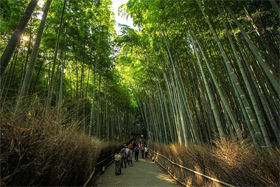 © Joe Mignano 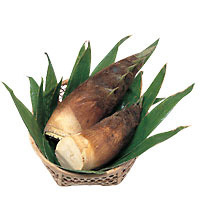 © Kono Toshihiko 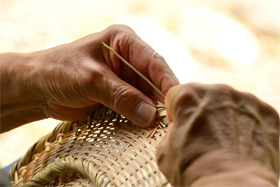 © Japan Up Close 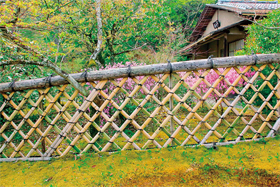 © Web Japan 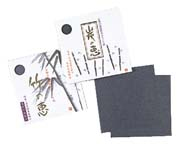 © Kono Toshihiko (Cooperation: Ohki Technological Creation Co., Ltd.) 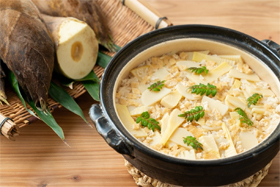 © Japan Up Close 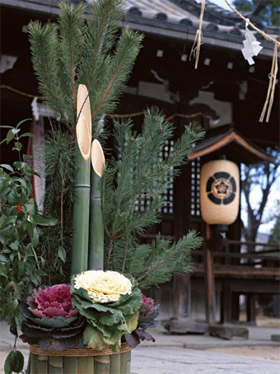 © Web Japan |
Resources
|
Larking, Matthew. 2020. Bamboo crafts: woven into Japan’s art history”. https://japanupclose.web-japan.org/culture/c20200401_2.html. “Japan in Photos – The Natural Beauty of Bamboo”. 2021. Japan Up Close. https://japanupclose.web-japan.org/culture/c20211201_7.html. “PAPER DRESSED, BAMBOO SKIRTS: Traditional Materials Find New Application in Clothing”. 2000. Web Japan. https://web-japan.org/trends00/honbun/tj000522.html . “Some Surprising Uses for Charcoal”. 2001. NIPPONIA. https://web-japan.org/nipponia/nipponia19/en/topic/topic02.html. “The Beauty of Knots, Refined by Unique Techniques”. 2020. niponica. https://web-japan.org/niponica/niponica29/en/feature/feature04-2.html. Sanada, Kuniko. 2004. “The Wisdom of Nature Passed Down Through The Ages”. niponica. https://web-japan.org/nipponia/nipponia31/en/feature/feature03.html. Itoh, Makiko. 2014. “Springtime for bamboo”. The Japan Times. https://www.japantimes.co.jp/life/2014/04/15/food/springtime-for-bamboo/. Closs, Christian. 2022. “Bamboo Shoots: Japan’s Favorite Spring Vegetable”. https://sakura.co/blog/bamboo-shoots-as-seasonal-food-in-japan/. “Raking In Good Fortune”. 2009. Web Japan. https://web-japan.org/trends/09_food/jfd091210.html. |
|
Japan Creative Centre 4 Nassim Road, Singapore 258372 +65 6737 0434 / jcc@sn.mofa.go.jp https://www.sg.emb-japan.go.jp/JCC/ Nearest parking at Orchard Hotel & Delphi Orchard |
 |